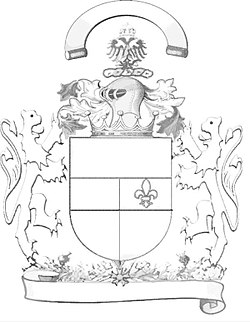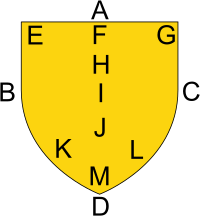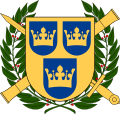The Coat Of Arms
What it really means, what is significant about it. How does it compare with other cultures acheivements.
 |
| A blank Coat Of Arms. Each area is designated for certain elements. The following diagram lists out what achievement goes where on the Coat Of Arms. Very strict rules by the way. |
B – Dexter
C – Sinister
D – Base
E – Dexter Chief
F – Middle Chief
G – Sinister Chief
H – Honour Point
I – Fess Point
J – Nombril Point
K – Dexter Base
L – Sinister Base
M – Middle Base (seldom used)
A coat of arms is a unique heraldic design on an escutcheon (i.e. shield), surcoat, or tabard. A surcoat, and subsequently a coat of arms was used by medieval knights to cover, protect, and identify the wearer. Thus these are sometimes called coat armory. The coat of arms on an escutcheon forms the central element of the full heraldic achievement which consists of shield, supporters, crest, and motto. The design is a symbol unique to an individual person or family (except in the UK), corporation, or state. Such displays are commonly called armorial bearings, armorial devices,heraldic devices, or simply arms.
Sometimes the term coat of arms is used to refer to the full achievement, but this usage is wrong in a strict sense of heraldic terminology.[1][2]
The ancient Romans used similar insignias on their shields, but these identified military units rather than individuals. The first evidence of medieval coats of arms is found in the Bayeux Tapestry from the 11th Century, where some of the combatants carry shields painted with crosses. Coats of arms came into general use by feudal lords and knights in battle in the 12th Century. By the 13th Century arms had spread beyond their initial battlefield use to become a kind of flag or logo for families in the higher social classes of Europe, inherited from one generation to the next. Exactly who had a right to use arms, by law or social convention, varied to some degree between countries. In the German-speaking region both the aristocracy and burghers (non-noble free citizens) used arms, while in most of the rest of Europe they were limited to the aristocracy. The use of arms spread to Church clergy, and to towns as civic identifiers, and to royally-chartered organizations such as universities and trading companies. Flags developed from coats of arms, and the arts of vexillology and heraldry are closely related. The coats of arms granted to commercial companies are a major source of the modern logo.
=====In the movie "THE EAGLE"
=====In the movie "THE EAGLE"
Despite no widespread regulation, and even with a lack in many cases of national regulation, heraldry has remained rather consistent across Europe, where traditions alone have governed the design and use of arms.[citation needed] Unlike seals and other general emblems, heraldic achievements have a formal description called a blazon, expressed in a jargon that allows for consistency in heraldic depictions.
In the 21st century, coats of arms are still in use by a variety of institutions and individuals; for example, many European cities and universities have guidelines on how their coats of arms may be used, and protect their use as trademarks.[3][4][5] Many societies exist that also aid in the design and registration of personal arms. Some nations, like England and Scotland, still maintain the same heraldic authorities which have traditionally granted and regulated arms for centuries and continue to do so in the present day.
Shapes of the Sheild veried.
Shapes of the Sheild veried.
 |
Examples of escutcheon shapes: 1: mediaeval French & English "heater style"; 2: modern French; 3: cartouche (oval); 4: lozenge (usually borne by women); 5: rectangular; 6: Italian; 7: Swiss, 8: English,Tudor arch (16th century); 9: à bouche; 10: Polish; 11: traditional IberianInescutcheons as mobile charges[edit]
Inescutcheons may appear in personal and civic armory as simple mobile charges, for example the arms of the House of Mortimer or the noble French family of Abbeville. These mobile charges are of a particular tincture but do not necessarily bear further charges and may appear anywhere on the main escutcheon, their placement being specified in the blazon, if in doubt.
Inescutcheons may also be charged with other mobile charges, such as in the arms of the Swedish Collegium of Arms (illustrated below) which bears the three crowns of Sweden, each upon its own escutcheon upon the field of the main shield. These inescutcheons serve as a basis for including other charges that do not serve as an augmentation or hereditary claim. In this case, the inescutcheons azure allow the three crowns of Sweden to be placed upon a field, thus not only remaining clearly visible but also conforming to the rule of tincture.
Inescutcheon of pretence[edit]
Inescutcheons may also be used to bear another's arms in "pretense".[note 1] In English Heraldry the husband of an heraldic heiress, the sole daughter and heiress of an armigerous man (i.e. a lady without any brothers), rather than impaling his wife's paternal arms as is usual, must place her paternal arms in an escutcheon of pretence in the centre of his own shield as a claim ("pretence") to be the new head of his wife's family, now extinct in the male line. In the next generation the arms are quartered by the son.
Use by monarchs and states[edit]
A monarch's personal or hereditary arms may be borne on an inescutcheon en surtout over the territorial arms of his/her domains,[note 2] as in the arms of Spain, thecoats of arms of the Danish Royal Family members, the greater coat of arms of Sweden, or the arms of Oliver Cromwell as Lord Protector of the Commonwealth of England (1653–1659). The early Georgian kings of England bore an inescutcheon of the royal arms of Hanover on the arms of the Stuart monarchs of Great Britain, whose territories they now ruled.
This is mearly a small introduction to Coat Of Arms. Please discover more.
All visual items came from Wikipedia
|


No comments:
Post a Comment